Section 6A of the Citizenship Act, 1955

- 19 Oct 2024
In News:
A Constitution Bench of the Supreme Court, in a majority judgment of 4:1 ratio, upheld the constitutionality of Section 6A of the Citizenship Act, 1955, which permits immigrants from Bangladesh residing in Assam to secure Indian citizenship, as a valid piece of legislation aligned to the Preambular value of fraternity.
Background:
- Section 6A of the Citizenship Act, 1955, deals with the citizenship status of immigrants from Bangladesh who entered Assam before March 25, 1971.
- Introduced as part of the 1985 Assam Accord, it provides a special provision for Assam due to the unique demographic challenges posed by large-scale migration from Bangladesh.
Key Aspects of the Supreme Court Ruling
Majority Opinion
- Constitutional Validity: The Court reaffirmed that Section 6A does not violate Articles 6 and 7 of the Constitution. These Articles set the cut-off for granting citizenship to migrants from East and West Pakistan. Section 6A, operating from a later date, is distinct and does not interfere with these earlier constitutional provisions.
- Justification of Cut-off Date: The March 25, 1971 cut-off date is upheld as reasonable. This date coincides with Operation Searchlight, launched by the Pakistani Army to suppress the Bengali nationalist movement. Migrants arriving before this date are considered part of India's post-partition demographic landscape.
- Fraternity and Equal Treatment: The Court emphasized that the principle of fraternity, as enshrined in the Preamble, cannot be selectively applied. Immigrants who arrived before March 25, 1971, are entitled to citizenship, while those arriving after are considered illegal immigrants. The ruling aims to balance the humanitarian aspect of migration with the state's right to protect its cultural and economic integrity.
- Historical Context: The judgment also invoked the Assam Accord, which was designed to address the issue of large-scale migration from Bangladesh, providing a political solution to Assam’s concerns. The Court held that the special provisions for Assam under Section 6A do not violate Article 14 (equality before the law) due to the distinct situation in Assam compared to the rest of India.
Section 6A of the Citizenship Act: Provisions and Purpose
- Section 6A was introduced under the 1985 Citizenship (Amendment) Act following the Assam Accord. It allows migrants who entered Assam before January 1, 1966, to automatically gain citizenship. For those entering between January 1, 1966, and March 25, 1971, citizenship can be granted after fulfilling specific conditions.
- Exclusion of Post-1971 Migrants: Migrants arriving in Assam after March 25, 1971, are not eligible for Indian citizenship under Section 6A and are considered illegal immigrants.
- Assam Accord Context: The Assam Accord sought to resolve the issue of illegal immigration from Bangladesh and address the political, cultural, and economic concerns of the indigenous Assamese population. It set the cut-off date of March 25, 1971, as a landmark for distinguishing between legal and illegal migrants.
Implications of the Supreme Court Judgment
Impact on Immigrant Recognition
- Continued Citizenship: By upholding Section 6A, the Court grants continued citizenship rights to immigrants from Bangladesh who entered Assam before the cut-off date of March 25, 1971. This decision affirms India's commitment to protect those displaced by the Bangladesh Liberation War.
Assamese Identity Preservation
- Cultural Protection: The majority opinion dismissed concerns that the presence of immigrants would infringe upon the cultural and linguistic rights of the Assamese people. The Court emphasized that existing constitutional safeguards (e.g., Article 29(1)) are sufficient to preserve the unique identity of the Assamese community, even in the face of demographic changes.
Demographic and Economic Impact
- Tensions on Demographic Shift: Critics argue that the continued influx of migrants, though legally recognized, may strain Assam’s demographic balance, potentially threatening its cultural identity and economic resources. This could fuel local demands for stricter immigration controls and increase political mobilization around cultural preservation.
- Resource Allocation Challenges: The judgment implies that immigrants who are granted citizenship will have access to public resources, adding pressure on Assam's limited economic resources. This may necessitate the implementation of more robust policies for equitable resource distribution.
Pressure on Immigration Laws and Enforcement
- Immigration Law Enforcement: The judgment stresses the need for more effective enforcement of immigration laws, particularly regarding the detection and deportation of illegal immigrants who entered Assam post-1971. The inefficiencies in the current mechanisms for detecting such immigrants were criticized, and the Court called for judicial oversight to improve the enforcement process.
Regional and International Implications
- Bangladesh Relations: The decision, by excluding post-1971 immigrants from citizenship, may strain India-Bangladesh relations, as it could be perceived as India pushing responsibility for these migrants onto Bangladesh. This has the potential to complicate regional cooperation on issues like border management, migration control, and security.
Conclusion: Balancing Humanitarian and Political Interests
The Supreme Court’s decision to uphold Section 6A of the Citizenship Act, 1955, reflects a delicate balance between humanitarian concerns—acknowledging the plight of displaced persons—and the political necessity of protecting Assam’s cultural and demographic integrity. While the judgment provides clarity on the legal status of immigrants in Assam, it also highlights the need for efficient immigration enforcement, greater judicial oversight, and equitable resource management to address the ongoing challenges posed by migration in the region.
India - Canada Relations

- 18 Oct 2024
In News:
India-Canada relations have recently faced serious setbacks following allegations of India's involvement in the killing of Khalistani leader Hardeep Singh Nijjar in Canada. These claims have led to escalating diplomatic tensions and mutual expulsions of diplomats between the two countries.
Recent Developments in India-Canada Relations
- Assassination of Hardeep Singh Nijjar:
- Nijjar, a prominent Khalistani leader, was assassinated in British Columbia, Canada.
- The Canadian Prime Minister accused Indian officials of involvement, which India has denied as "absurd."
- Diplomatic Fallout:
- Both nations expelled each other's diplomats, reducing diplomatic staff and freezing consular services, exacerbating the tensions.
- Support from the Five Eyes Alliance:
- Canada enlisted the Five Eyes intelligence alliance to gain international backing amid the escalating diplomatic crisis with India.
What is the Five Eyes Alliance?
- About:
- The Five Eyes is a multilateral intelligence alliance composed of Australia, Canada, New Zealand, the United Kingdom, and the United States.
- These countries cooperate on signals intelligence under the UK-USA Agreement.
- Expansion:
- The alliance later grew into the Nine Eyes and Fourteen Eyes alliances, incorporating additional countries like the Netherlands, Denmark, France, Norway, and others.
Key Areas of India-Canada Relations
- Political Relations:
- Diplomatic ties began in 1947, with both countries sharing democratic values, human rights, and pluralism.
- Collaborative efforts in global forums like the UN, G20, and Commonwealth focus on climate change, security, and sustainable development.
- Economic Cooperation:
- Bilateral trade in 2023 was worth USD 9.36 billion.
- Canada is the 18th largest investor in India with investments totaling USD 3.3 billion (2000-2023).
- Ongoing Comprehensive Economic Partnership Agreement (CEPA) negotiations aim to boost trade in goods, services, and investments.
- Diaspora Connections:
- Over 1.8 million people of Indian origin in Canada, contributing significantly to cultural and economic exchanges.
- Canada is home to one of the largest Indian diaspora populations globally.
- Education and Space Innovation:
- IC-IMPACTS promotes joint research in healthcare, agricultural biotechnology, and waste management.
- Space collaboration includes partnerships between ISRO and the Canadian Space Agency.
- Indian students represent nearly 40% of Canada's international student population.
- Nuclear Cooperation:
- A 2010 nuclear agreement allows the supply of uranium to India and establishes a Joint Committee for oversight.
- Strategic Importance:
- India’s role is key in Canada’s Indo-Pacific strategy, including collaboration on maritime security, counter-terrorism, and regional stability.
Challenges in India-Canada Relations
- Diplomatic Immunity Issues:
- Canada invoked the Vienna Conventions to protect its diplomatic staff amid tensions, with both sides highlighting the importance of maintaining diplomatic norms.
- Khalistan Issue:
- India views Canada’s tolerance of Khalistani separatist groups as a threat to its territorial integrity.
- Canada’s investigation into India’s alleged role in Nijjar’s assassination has exacerbated diplomatic mistrust.
- Economic and Trade Barriers:
- The political rift has stalled negotiations for the CEPA and slowed bilateral trade.
- Canadian investments in India face increased uncertainty due to deteriorating relations.
- Visa and Immigration Delays:
- Reduced Canadian diplomatic staff in India has caused significant delays in visa processing, especially for students.
- Geopolitical Implications:
- Tensions between India and Canada risk damaging India’s reputation on the global stage, particularly if allegations of intelligence overreach are substantiated.
- Canada’s membership in the G7 and ties with the Five Eyes make the situation complex, affecting relations with other strategic partners of India, including the US, UK, Australia, and Japan.
The Vienna Convention on Diplomatic Immunity
- Vienna Convention on Diplomatic Relations (1961): Establishes the framework for the treatment and protection of diplomatic missions and their personnel.
- Diplomatic Immunity: Diplomats are protected from arrest and detention by the host country.
- Inviolability of Diplomatic Premises: Diplomatic missions cannot be entered without permission.
- Protection of Consular Officers: Ensures consular officers can assist their nationals without interference.
Way Forward for India-Canada Relations
- Address the Khalistan Issue: Engage in active dialogue to resolve concerns about the Indian diaspora and the Khalistan movement, respecting each other’s sovereignty.
- Strengthen Economic Ties:
- Revitalize CEPA negotiations, with a focus on sectors like technology, renewable energy, and infrastructure.
- Enhance trade and investment frameworks for mutually beneficial opportunities.
- Balance Geopolitical Interests:
- Both nations should navigate relationships with major powers like the US, China, and Russia with care.
- A cautious approach is necessary to maintain strategic partnerships without further conflict.
- Leverage Multilateral Platforms: Utilize forums like the G7 and Five Eyes to address global challenges and promote shared values, while working to stabilize bilateral ties.
Conclusion
India-Canada relations are at a critical juncture due to recent tensions. While historical ties and shared interests provide a strong foundation, the diplomatic fallout requires careful management. Both nations must seek ways to restore dialogue, address sensitive issues like the Khalistan movement, and focus on economic cooperation to stabilize and strengthen the relationship moving forward.
Global Hunger Index 2024
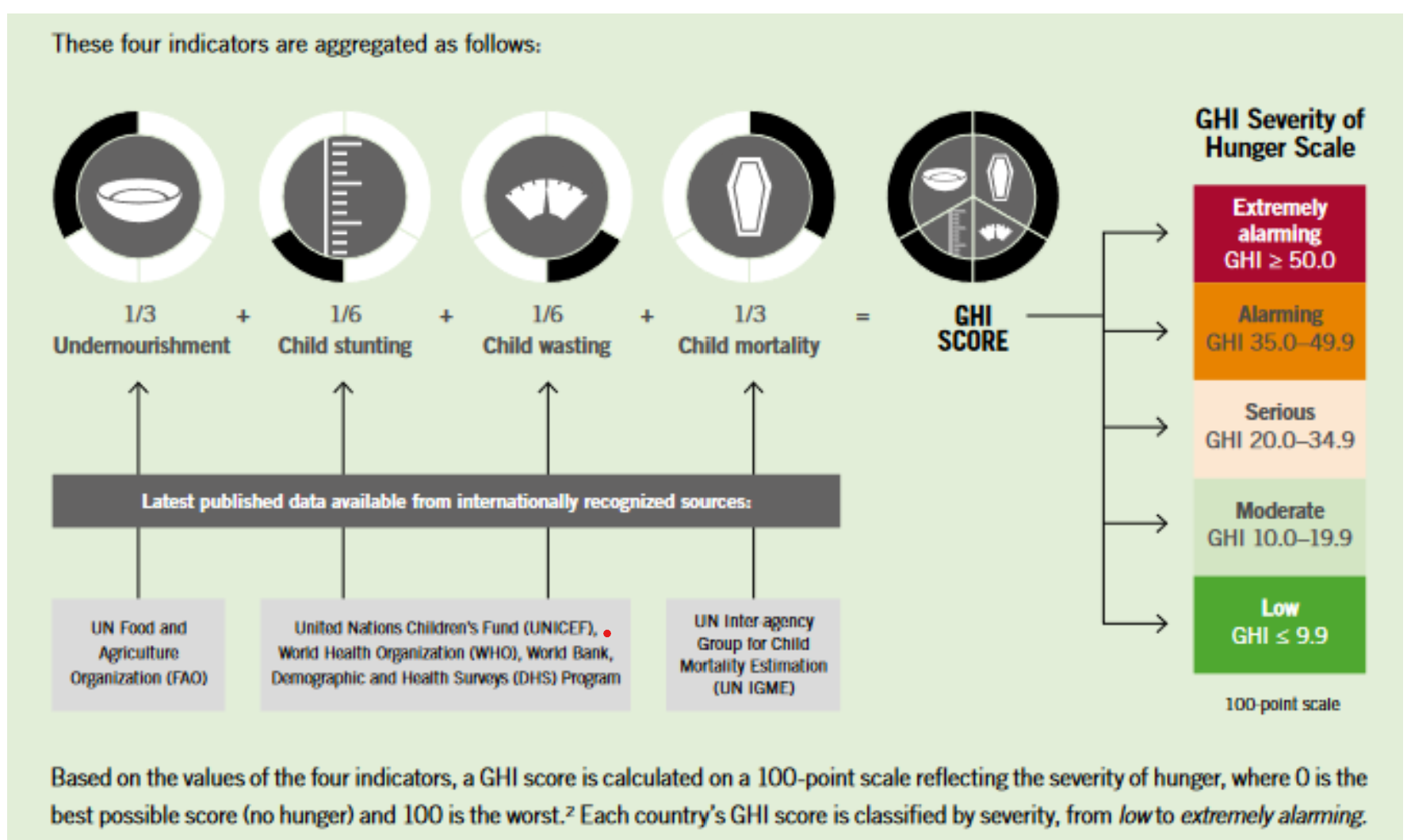
- 17 Oct 2024
Why in the news?
India is ranked 105th among 127 countries in the Global Hunger Index (GHI) 2024, indicating a ‘serious’ level of hunger, along with Afghanistan and Pakistan, which also face hunger challenges.
According to the Global Hunger Index released on 10th October 2024, the hunger levels in 42 countries are at alarming levels, making the goal of Zero Hunger by 2030 unattainable. At this pace of progress, the world will not even attain a low hunger level until 2160. The world’s GHI score is 18.3, which is considered moderate in the severity of hunger scale.
Key Takeaways:
1. The GHI is published by Concern Worldwide and Welthungerhilfe annually to measure and track hunger at global, regional, and national levels. The purpose of the report is to create awareness and understanding of the struggle against hunger and call attention to those areas of the world where hunger levels are highest and there is a need for additional efforts.
2. GHI is calculated based on a formula that combines four indicators that together capture the multidimensional nature of hunger:
- Undernourishment: the share of the population whose caloric intake is insufficient;
- Child stunting: the share of children under the age of five who have low height for their age, reflecting chronic undernutrition;
- Child wasting: the share of children under the age of five who have low weight for their height, reflecting acute undernutrition; and
- Child mortality: the share of children who die before their fifth birthday, reflecting in part the fatal mix of inadequate nutrition and unhealthy environments.
3. The 2024 GHI reflects that multiple factors are posing challenges in attaining Zero Hunger. The challenges include large-scale armed conflicts, climate change indicators that are worsening faster than expected, high food prices, market disruptions, economic downturns, and debt crises in many low- and middle-income countries.
4. The report highlights the link between Gender inequality, climate change, and hunger. Gender is intertwined with climate and food security challenges in ways that respective policies and interventions often ignore. Women and girls are typically hardest hit by food insecurity and malnutrition. They also suffer disproportionately from the effects of weather extremes and climate emergencies.
5. Six countries – Somalia, Yemen, Chad, Madagascar, Burundi, and South Sudan- have levels of hunger considered alarming. This is the result of widespread human misery, undernourishment, and malnutrition.
What is Hunger?
The Food and Agriculture Organization of the United Nations (FAO) defines hunger as food deprivation, or undernourishment, as the habitual consumption of too few calories to provide the minimum dietary energy an individual requires to live a healthy and productive life, given that person’s sex, age, stature, and physical activity level.
6. India ranked 105th out of 125 countries in the Global Hunger Index 2024, with a score of 27.3, indicating a serious level of hunger. Child wasting is particularly high in India. Child undernutrition in India goes hand in hand with the poor nutritional status of mothers, suggesting an intergenerational pattern of undernutrition and underscoring the need for attention to maternal health nutrition and infant feeding.
7. India’s GHI score of 27.3 is a cause for concern, especially when compared to its South Asian neighbours like Bangladesh, Nepal, and Sri Lanka, which fall into the “moderate” category
8. The performance of India on various parameters of GHI:
- 13.7 per cent of India’s population suffers from undernourishment,
- 35.5 per cent of children under the age of five are stunted
- 18.7 per cent experience child wasting and
- 2.9 per cent of children do not reach their fifth birthday.
9. The policy recommendations made in the document include strengthening accountability to international law and the enforceability of the right to adequate food, promoting gender-transformative approaches to food systems and climate policies and programs, and making investments that integrate and promote gender, climate, and food justice.
National Family Health Survey
1. The National Family Health Survey (NFHS) in India provides estimates of underweight, (low weight for age), stunting (low height for age), and wasting (low weight for height). These conditions affect preschool children (those less than 6 years of age) disproportionately and compromise a child’s physical and mental development while also increasing the vulnerability to infections.
2. According to the NFHS 5, the percentage of stunted, wasted, and underweight children is 36 per cent, 19 per cent and 32 per cent respectively.
(Thought Process: These data can be incorporated in your Mains Answer Writing to enrich your content.)
3. NFHS 5 highlighted that among mothers with a child between ages 6-23 months, 18 per cent reported that their child did not eat any food whatsoever — referred to as “zero-food” — in the 24 hours preceding the survey. The zero-food prevalence was 30 per cent for infants aged 6-11 months, remains worryingly high at 13 per cent among the 12-17 months old, and persists even among 18-23 months-old children at 8 per cent.
Hidden Hunger
In India, we suffer largely from “hidden hunger” which does not always manifest itself in an emaciated appearance. It is a hunger caused by the constant or recurrent lack of food of sufficient quality and quantity. It is the deprivation of vitamins and minerals, essential micronutrients that are necessary for proper growth, physical fitness, and mental development.
4. Going without food for an entire day at this critical period of a child’s development raises serious concerns related to severe food insecurity. According to the World Health Organisation, at six months of age, 33 per cent of the daily calorie intake is expected to come from food. This proportion increases to 61 per cent at 12 months of age. The recommended calorie percentages mentioned here are the minimum amount that should come from food.
5. India has a challenging task in attaining the Sustainable Development Goal (SDG) 2 of “zero hunger”. Mission Poshan 2.0, the overarching flagship programme dedicated to maternal and child nutrition, has evolved in the right direction by targeting SDG 2 “zero hunger” and focusing on food-based initiatives, including its flagship supplementary nutrition programme service as mandated by the 2013 National Food Security Act.
Climate Change and Methane Emissions in the Amazon Rainforest

- 16 Oct 2024
Overview
Recent research from the University of São Paulo reveals that climate change is poised to significantly disrupt the methane cycle in the Amazon rainforest, with potential global repercussions. Rising temperatures and increased flooding are impacting microbial activity in both floodplain and upland forest soils, leading to contrasting changes in methane dynamics.
Key Findings
- Methane Uptake Reduction: The study indicates that methane absorption in upland forest soils could decrease by as much as 70% in warmer, drier conditions. This reduction diminishes the forest's role as a methane sink.
- Floodplain Contributions: Floodplains, which cover over 800,000 square kilometers during the rainy season, contribute up to 29% of global wetland methane emissions. Here, methane-producing microbes thrive due to the breakdown of organic matter.
Understanding the Methane Cycle
- Definition: The methane cycle encompasses the processes that control the production, consumption, and release of methane (CH4) in the environment.
- Microbial Roles:
- Methanogens produce methane, primarily in waterlogged conditions.
- Methanotrophs consume methane, living in drier, oxygen-rich soils. These interactions are critical in regulating methane levels in the atmosphere.
- Sources and Sinks: While wetlands and other environments release methane, hydroxyl radicals (OH) in the troposphere act as a natural sink, helping to oxidize methane into carbon dioxide.
Climate Change Impacts on the Methane Cycle
- Imbalance of Sources and Sinks: As global temperatures rise, the release of methane from soils may increase, exacerbating climate change effects.
- Melting Clathrates: Methane clathrates, trapped in cold sediments, are at risk as warming causes them to release methane, further contributing to greenhouse gas concentrations.
Global Consequences of Methane Disruption
- Climate Change Amplifier: Methane is the second most significant greenhouse gas, with a global warming potential 28 times greater than carbon dioxide over a century.
- Air Quality and Health: Increased methane emissions can lead to higher levels of tropospheric ozone, resulting in respiratory health issues and reduced air quality.
- Biodiversity Threats: The changes in methane dynamics can destabilize ecosystems, leading to shifts in species distributions and loss of biodiversity.
Balancing the Methane Cycle
To mitigate the impacts of methane emissions, various strategies can be employed:
- Enhanced Landfill Design: Utilizing gas collection systems to capture methane for energy rather than allowing it to escape.
- Livestock Management: Introducing feed additives to reduce methane emissions from ruminants.
- Sustainable Agricultural Practices: Implementing techniques like alternative wetting and drying in rice cultivation to lower methane output.
- Soil Health Improvements: Promoting organic fertilization and crop rotation to foster aerobic conditions in soils.
Research Insights
The study involved subjecting soil samples from floodplains and upland forests to elevated temperatures and varying humidity levels. Results indicated:
- Stable methane emissions in floodplains alongside an increase in methane-producing microbes.
- A significant decline in methane uptake in upland soils due to temperature sensitivity, with higher temperatures reducing microbial diversity.
Conclusion
The Amazon rainforest plays a crucial role in regulating global methane levels, and its response to climate change is vital for understanding future greenhouse gas emissions. As these ecosystems face increased pressure from rising temperatures and changing hydrological conditions, it becomes imperative to enhance our understanding and management of methane dynamics to mitigate broader climate impacts.
Asset Monetisation
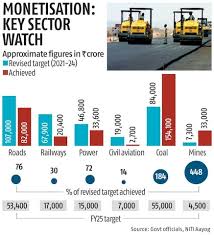
- 15 Oct 2024
In News
The NITI Aayog has recently increased the asset monetisation target for the fiscal year 2024-25 (FY25) by ?23,000 crore, bringing the total to ?1.9 trillion. This adjustment aligns with the broader target of ?6 trillion set under the National Monetisation Pipeline (NMP) for the period from FY 2022 to FY 2025.
Understanding Asset Monetisation
Definition
Asset monetisation refers to the process of converting public assets into revenue-generating assets without selling them outright. This includes using assets to generate profit or cash, thereby unlocking their economic value.
Importance
- Revenue Generation: Monetisation creates new revenue streams for governments by leveraging underutilised public assets.
- Focus on Public Assets: The emphasis is on monetising existing infrastructure such as roads, airports, railways, and pipelines, primarily targeting brownfield assets—those that can be improved or repurposed.
Monetisation vs. Privatisation
While privatisation involves complete ownership transfer to the private sector, asset monetisation allows public authorities to retain ownership while benefiting from private sector efficiencies through structured partnerships.
The National Monetisation Pipeline (NMP)
Overview
The NMP is an initiative aimed at promoting sustainable infrastructure financing through the monetisation of operational public assets. It envisions a monetisation potential of ?6 lakh crore, focusing on leasing core assets from the Central government and public sector entities.
Preparation and Coverage
- Collaborative Approach: Developed by NITI Aayog in consultation with infrastructure ministries such as Roads, Railways, and Power.
- Sector Coverage: Encompasses various sectors including roads (27% of the total value), railways (25%), power (15%), and telecom (6%).
Framework for Monetisation
- Retention of Rights: The government retains ownership, with assets reverting to public authorities post-transaction.
- Stable Revenue Streams: Focus on de-risked brownfield assets that provide consistent revenue.
- Defined Partnerships: Establishment of contractual frameworks with strict performance indicators.
Alignment with National Infrastructure Pipeline (NIP)
The NMP is integrated with the NIP, which seeks to attract investments in both greenfield and brownfield projects across all sectors.
Current Status of the NMP
Revenue Generation
As of FY24, the NMP has generated ?3.9 trillion, slightly below the original target of ?4.3 trillion for the initial three years.
Successful Monetisation Examples
- The Ministry of Coal exceeded its target, raising ?1.54 trillion against a goal of ?80,000 crore.
- Mining assets have also been monetised significantly, surpassing their revised targets.
Sectors Lagging
- Railways: Only ?20,417 crore monetised, achieving just 30% of the target.
- Civil Aviation: A mere 14% of its targeted monetisation has been achieved.
Challenges Facing the NMP
- Low Monetisation Potential: The NMP's ?6 lakh crore target represents only a small fraction (5-6%) of the total capital expenditure under the NIP.
- Disinvestment Issues: Many sectors chosen for monetisation have consistently fallen short of their disinvestment targets, raising doubts about achieving future goals.
- Long-Term Rights Concerns: Granting private entities long-term operational rights may be perceived as a form of privatisation, potentially leading to public distrust.
- Budget Clarity: There is a lack of transparency regarding how monetisation proceeds will be allocated within the government budget.
- Potential for Monopolies: Consolidation of asset ownership could lead to monopolistic practices, especially in critical infrastructure sectors.
- Taxpayer Concerns: Taxpayers are wary of the potential for double charges on public assets they initially funded.
Way Forward
- Accelerating Monetisation: The government should expedite contract-based monetisation through Public-Private Partnerships (PPP), particularly in sectors like railways and airports.
- Land Monetisation Initiatives: Engaging real estate companies to develop multi-storey buildings can generate additional revenue while enhancing housing options.
- Establishing Budget Guidelines: Clear budgeting guidelines should be developed to clarify the allocation of funds generated from monetisation, ensuring they are used for infrastructure development rather than operational expenses.
Navigating the Middle-Income Trap: Challenges and Solutions for India

- 14 Oct 2024
Introduction
The World Development Report 2024 addresses the phenomenon of the middle-income trap, where countries struggle to maintain growth as they transition from low to middle-income status. This report advocates for a "3i" approach—Investment, global Technology infusion, and domestic Innovation—to overcome this challenge. India faces specific hurdles, including stagnant exports, rising protectionism, and premature deindustrialization.
Understanding the Middle-Income Trap
Definition and Characteristics
- A middle-income trap occurs when a country, after achieving middle-income status, fails to progress to high-income status.
- This phenomenon typically arises when a country's per capita income reaches about 11% of US levels, leading to:
- High wage levels that diminish competitiveness against low-wage economies.
- Insufficient technological advancement to compete with high-income nations.
Economic Implications
- Traditional growth drivers become ineffective.
- Rising wages in labor-intensive sectors decrease competitiveness, while innovation and productivity remain stagnant.
Historical Context: India’s Income Evolution
1. Post-Independence Era (1950s-1970s)
- Per Capita Income: ?265 in 1950-51.
- Growth Rate: 3.5%, dominated by agriculture.
- Economic Structure: Heavy state intervention and public sector focus.
2. Liberalization Phase (1980s-1990s)
- Per Capita Income Growth: Accelerated to 5.6%.
- Major Shift: 1991 liberalization led to a rise in the services sector and an expanding middle class.
3. High Growth Phase (2000-2010)
- GDP Growth: 8-9% annually.
- Per Capita Income: Increased from ?16,173 in 2000-01 to ?24,295 in 2007-08.
- Sectoral Dominance: Surge in software and services exports.
4. Mixed Growth Phase (2010-2020)
- Growth Volatility: Average of 6-7%.
- Wealth Inequality: Top 1% owned 40.5% of national wealth by 2021.
5. Post-Covid Recovery (2020-Present)
- GDP: Reached $3.75 trillion.
- Current Issues: Unemployment at 8.1%, while digital payment systems expanded.
Challenges in Overcoming the Middle-Income Trap
1. Premature Deindustrialization
- The manufacturing sector's GDP share has stagnated at 15-17%, far below the target of 25%.
- Limits potential productivity gains and innovation.
2. Limitations of Services-Led Growth
- Over-reliance on the services sector hampers mass employment and inclusive growth.
3. Declining Total Factor Productivity (TFP)
- TFP growth has been declining, indicating a shift toward input-driven growth rather than efficiency-driven growth.
4. Informal Sector Dominance
- The informal economy comprises about 90% of the workforce, leading to low productivity and limited access to technology.
5. Risk of a Demographic Burden
- Youth unemployment is rising, with only 2.3% of the workforce receiving formal skill training.
6. Global Economic Headwinds
- Slowing global growth affects India’s export-led strategies, with a recent contraction in merchandise exports.
7. Infrastructure and Logistics Bottlenecks
- India ranks 38th in the World Bank’s Logistics Performance Index, highlighting significant infrastructure gaps.
Strategic Measures for India
1. Enhance Manufacturing Competitiveness
- Targeted Industrial Policies: Refine the Production-Linked Incentive scheme and extend it to emerging sectors like green hydrogen.
2. Accelerate Digital Infrastructure and Skills Development
- Leverage India's digital platforms to create a skills ecosystem and modernize vocational training.
3. Boost R&D Expenditure
- Increase public R&D spending to 2% of GDP by 2030, focusing on key sectors like renewable energy.
4. Foster an Innovation-Driven Manufacturing Policy
- Shift focus to high-value specialized manufacturing rather than competing in mass production.
5. Integrate Skills and Education
- Align educational curricula with industry needs and establish centers of excellence in tier-2 and tier-3 cities.
6. Lead in Green Technology
- Scale initiatives like the International Solar Alliance and create a national carbon market.
7. Reform Market Regulations
- Liberalize product and factor markets to enhance competition and efficiency.
Conclusion
India's path out of the middle-income trap necessitates a concerted effort to boost manufacturing, foster innovation, and address productivity challenges. By leveraging digital infrastructure and enhancing skills, alongside adopting green technologies, India can create a sustainable framework for growth. Effective execution of targeted policies will be crucial for transitioning to a high-income economy.
ASEAN SUMMIT

- 11 Oct 2024
In News:
The 21st ASEAN-India Summit took place in Vientiane, Lao PDR, on 10 October 2024. This summit coincided with the 10th anniversary of India’s Act East Policy. Prime Minister Narendra Modi joined ASEAN leaders to assess the progress of the ASEAN-India Comprehensive Strategic Partnership and set the course for future collaboration.
In his address, Prime Minister Modi reaffirmed India's strong support for ASEAN Unity, ASEAN Centrality, and the ASEAN Outlook on the Indo-Pacific. Referring to the 21st century as the “Asian century,” he emphasized the pivotal role of India-ASEAN relations in shaping Asia’s future. He highlighted the success of India’s Act East Policy, noting that in the last decade, trade between India and ASEAN had doubled to over USD 130 billion, with ASEAN becoming one of India’s top trade and investment partners. He also pointed out direct flight connections with seven ASEAN countries, advancements in Fin-tech collaborations, and efforts to restore shared cultural heritage in five ASEAN nations. PM Modi also stressed the importance of completing the review of the ASEAN-India Free Trade Agreement (AITIGA) promptly to unlock greater economic potential. He spoke about the progress made in the India-ASEAN knowledge partnership, particularly through scholarships for ASEAN students at Nalanda University.
In line with the summit’s theme of ‘Enhancing Connectivity and Resilience", PM Modi announced a 10-point plan, which includes:
- Celebrating 2025 as the ASEAN-India Year of Tourism, with USD 5 million allocated for joint initiatives.
- Marking a decade of the Act East Policy through people-centric activities like a Youth Summit, Start-up Festival, Hackathon, Music Festival, ASEAN-India Network of Think Tanks, and Delhi Dialogue.
- Organizing an ASEAN-India Women Scientists Conclave under the ASEAN-India Science and Technology Development Fund.
- Doubling scholarships at Nalanda University and offering new scholarships for ASEAN students at Indian agricultural universities.
- Reviewing the ASEAN-India Trade in Goods Agreement by 2025.
- Enhancing disaster resilience, with India contributing USD 5 million.
- Initiating a new Health Ministers’ track for building health resilience.
- Establishing a regular ASEAN-India Cyber Policy Dialogue to strengthen digital and cyber resilience.
- Hosting a workshop on Green Hydrogen.
- Inviting ASEAN leaders to join the ‘Plant a Tree for Mother’ campaign to promote climate resilience.
During the summit, leaders agreed to develop a new ASEAN-India Plan of Action (2026-2030) to guide future cooperation and adopted two joint statements:
- Joint Statement on Strengthening ASEAN-India Comprehensive Strategic Partnership for Peace, Stability, and Prosperity in the Indo-Pacific, highlighting the role of India’s Act East Policy in advancing the ASEAN-India relationship.
- ASEAN-India Joint Statement on Advancing Digital Transformation, recognizing India’s leadership in digital transformation and embracing a partnership in digital public infrastructure.
Prime Minister Modi expressed his gratitude to the Prime Minister of Laos for successfully hosting the summit and to Singapore for its role as Country Coordinator over the past three years. He looked forward to working with the Philippines, the new Country Coordinator for India.
ABOUT Association of Southeast Asian Nations (ASEAN)
- ASEAN is a political and economic organization focused on fostering economic growth and regional stability among its member countries.
- The member states include Brunei, Cambodia, Indonesia, Laos, Malaysia, Myanmar, the Philippines, Singapore, Thailand, and Vietnam.
- ASEAN was founded in 1967 in Bangkok, Thailand, with the signing of the ASEAN Declaration (Bangkok Declaration) by its original members: Indonesia, Malaysia, the Philippines, Singapore, and Thailand. Brunei Darussalam joined in 1984, followed by Vietnam in 1995, Lao PDR and Myanmar in 1997, and Cambodia in 1999.
ASEAN Summit:
- This is ASEAN’s highest decision-making body, consisting of the heads of state or government of member nations. The summit is held twice a year.
- The first ASEAN Summit took place in 1976 in Bali, Indonesia.
The Mental Health Crisis in India

- 10 Oct 2024
In News:
India faces a significant mental health crisis, driven by various factors including economic disparities, social isolation, and changing family dynamics. The pandemic further worsened these issues, leading to detrimental effects on mental well-being.
Causes of Mental Illness
- Socioeconomic Factors: Poverty, violence, inequality, and environmental deprivation contribute to rising mental health issues.
- Pandemic Impact: Lockdowns and uncertainties have heightened stress levels and anxiety.
- Adverse Life Experiences: Trauma, abuse, and dysfunctional family relationships can severely impact mental health.
- Cultural Pressures: The urban focus on consumerism and status can lead to feelings of inadequacy and dissatisfaction.
The Shortage of Mental Health Professionals
India's mental health services are severely lacking, with only 0.75 psychiatrists per 100,000 population—far below the World Health Organization's recommendation of three. This shortage underscores the need for policy interventions and incentives to increase the supply of mental health professionals.
Government Initiatives for Mental Health
The Indian government has implemented several initiatives to improve mental health care:
- National Mental Health Programme (NMHP): Launched in 1982 to enhance community-based mental health services.
- Mental Healthcare Act, 2017: Decriminalized suicide attempts and introduced advanced directives for treatment choices.
- Rights of Persons with Disabilities Act, 2017: Recognizes mental illness as a disability, enhancing rights for affected individuals.
- Manodarpan Initiative: Provides psycho-social support to students.
- Kiran Helpline: A suicide prevention helpline for crisis management.
- National Tele-Mental Health Programme: Launched in 2022 to expand access to mental health services, particularly in underserved areas.
Economic Survey 2023-24
For the first time, the Economic Survey emphasized the importance of mental health in policy recommendations, calling for effective implementation of mental health initiatives to address existing gaps.
Understanding Healthy Workplaces
Defining a Healthy Workplace
A healthy workplace fosters collaboration between employers and employees to promote physical and psychological safety. It encompasses open communication, respect, and a supportive environment, crucial for addressing workplace stress, anxiety, and burnout.
Current Crisis: Overwork and Mental Health
The phenomenon of ‘Karoshi’ (death from overwork) highlights the severe consequences of workplace stress. In India, 40% of employees report high stress levels due to excessive work demands.
Ethical Perspectives on Healthy Workplaces
Creating a healthy workplace involves:
- Fairness and Equity: Ensuring all employees have equal access to resources and opportunities.
- Respect for Individual Dignity: Acknowledging contributions and fostering psychological safety.
- Moral Responsibility of Employers: Providing a safe working environment and promoting mental health initiatives.
- Transparency and Accountability: Building trust through open communication about policies and practices.
- Promoting Work-Life Balance: Encouraging a balance between professional and personal life to prevent burnout.
Global Precedents for Work-Life Balance
Countries like Australia and France have introduced regulations, such as the ‘right to disconnect,’ allowing employees to disengage from work communications after hours.
Conclusion and Way Forward
Establishing healthy workplaces is not merely a regulatory compliance issue but an ethical commitment to employee well-being. Both employers and employees must collaborate to create an environment of psychological safety, open communication, and mutual respect. By prioritizing these principles, organizations can foster workplaces that enhance productivity and support mental health, ultimately driving innovation and improving overall well-being.
MeitY relaxes AI compute procurement norms for Start-ups

- 09 Oct 2024
Overview
The Ministry of Electronics and IT (MeitY) has relaxed certain provisions related to the procurement of computing capacity for artificial intelligence (AI) solutions. This decision is part of the Rs 10,370 crore IndiaAI Mission, aimed at enhancing the country’s AI capabilities.
Key Relaxations
Annual Turnover Requirements
- Primary Bidders: Turnover requirement reduced from ?100 crore to ?50 crore.
- Non-Primary Consortium Members: Requirement halved from ?50 crore to ?25 crore.
Computing Capacity Adjustments
- The performance threshold for successful bidders has been revised:
- FP16 Performance: Reduced from 300 TFLOPS to 150 TFLOPS.
- AI Compute Memory: Reduced from 40 GB to 24 GB.
Importance of the Changes
These adjustments respond to concerns raised by smaller companies about exclusionary requirements that favored larger firms. The aim is to create an inclusive environment that allows start-ups to participate in the AI landscape.
AI Mission Goals
- Establish a computing capacity of over 10,000 GPUs.
- Develop foundational models with capacities exceeding 100 billion parameters.
- Focus on priority sectors such as healthcare, agriculture, and governance.
New Technical Criteria
- Companies must demonstrate experience in offering AI services over the past three financial years.
- Minimum billing of ?10 lakh required for eligibility.
Local Sourcing Requirements
- Components for cloud services must be procured from Class I or Class II local suppliers as per the ‘Make in India’ initiative:
- Class I Supplier: Domestic value addition of at least 50%.
- Class II Supplier: Local content between 20-50%.
Data Sovereignty and Service Delivery
- All AI services must be delivered from data centres located in India.
- Data uploaded to cloud platforms must remain within India's sovereign territory.
Implementation Strategy
- The Rs 10,370 crore plan will be implemented through a public-private partnership model.
- 50% viability gap funding has been allocated for computing infrastructure development.
Conclusion
The relaxations in AI compute procurement norms aim to support the growth of start-ups in India, fostering an environment conducive to innovation in artificial intelligence. With these changes, smaller companies are better positioned to contribute to the country's ambitious AI goals.
How India can harness the power of AI to become a Trailblazer

- 08 Oct 2024
Introduction
India stands at the forefront of an AI revolution, poised to leverage its unique position for unprecedented growth and innovation. With a robust economic outlook, the nation is ready to transform its AI capabilities.
Economic Landscape
Projected Growth
- Nomura estimates India's economy will grow at an average rate of 7% over the next five years, surpassing the IMF's global growth forecast of 3.2% for 2024.
- Hosting the G20 and Global Partnership on AI meetings in 2023 has created a favorable geopolitical environment.
Market Potential
- India’s AI market is expected to reach $17 billion by 2027, with a growth rate of 25-35% annually from 2024 to 2027 (Nasscom).
- The country leads Asia Pacific in the use and adoption of Generative AI, with significant engagement from students and employees.
The Role of Industry
Driving Transformation
- Similar to historical industrial leaders, India Inc has the potential to drive significant change across various sectors.
- The goal is to transition from participation to leadership in the global AI ecosystem.
Sector-Specific Strategies
- Industries must align AI capabilities with specific sectoral goals by mapping challenges, opportunities, and ambitions.
Case Study: Logistics Sector
Historical Inefficiencies
- A decade ago, the logistics sector in India faced significant inefficiencies.
AI Integration
- Traditional AI introduced automation and basic forecasting. Companies like PandoAI have leveraged AI to consolidate supply chain data and provide valuable analytics.
- The integration of Generative AI can further enhance predictive capabilities and innovative solutions.
Infrastructure and Investment
Current Challenges
- India generates 20% of the world’s data but has only 2% of global data centers, limiting technological advancement.
Government Initiatives
- Plans to procure 10,000 GPUs in the next 18-24 months and a National Semiconductor Mission to establish a domestic chip industry.
Need for Industry Investment
- Collaboration between government and industry is crucial to meet the growing demands for computing power.
Talent Development
Workforce Dynamics
- Hiring of AI talent increased by 16.8% in 2023, indicating a rising focus on AI capabilities.
- Many Indian-origin AI professionals work for international companies, highlighting the need for local opportunities.
Educational Initiatives
- Programs like FutureSkills PRIME should be expanded to enhance talent development in AI.
Ethical Standards and Governance
Importance of Trust
- Establishing trustworthy AI standards is essential for consumer confidence and sustainable operation.
- Challenges such as bias and data security require robust governance frameworks.
Operationalizing Ethics
- Develop AI governance frameworks addressing ethical concerns and data security.
- Ensure transparency in AI algorithms and decision-making processes.
- Promote inclusive AI development by engaging diverse perspectives.
- Invest in ethical AI research through collaborations with academic institutions.
Conclusion
India’s commitment to a strategic vision, substantial investment, and adherence to trustworthy AI practices can position it as a global leader in the AI landscape. This is a pivotal moment for India to harness AI's transformative power, paving the way for a new era of economic prosperity.
National Agriculture Code (NAC)

- 07 Oct 2024
Introduction
The Bureau of Indian Standards (BIS) is in the process of developing the National Agriculture Code (NAC), which aims to establish standardized practices across the agricultural sector. This initiative mirrors existing frameworks such as the National Building Code and the National Electrical Code.
Purpose of the National Agriculture Code
The NAC seeks to standardize agricultural practices throughout the entire agricultural cycle, ensuring consistency and quality in farming operations. It will serve as a comprehensive guide for farmers, agricultural institutions, and policymakers.
Structure of the NAC
The NAC will be divided into two main parts:
- General Principles: Applicable to all crops, providing a foundational framework.
- Crop-Specific Standards: Tailored standards for key crops such as paddy, wheat, oilseeds, and pulses.
Coverage of the NAC
The code will encompass a wide range of agricultural processes, including:
- Agricultural Cycle: From crop selection to post-harvest operations.
- Post-Harvest Operations: Including standards for storage, processing, and traceability.
- Emerging Practices: Guidelines for natural and organic farming, as well as the integration of Internet-of-Things (IoT) technologies.
- Input Management: Recommendations for the use of fertilizers, pesticides, and weedicides.
Objectives of the National Agriculture Code
The BIS outlines several key objectives for the NAC:
- Standardization: Create a national code that reflects the diverse agro-climatic zones and socio-economic conditions across India.
- Quality Culture: Act as a reference for policymakers and regulators to enhance agricultural quality.
- Guidance for Farmers: Provide a practical guide to assist farmers in making informed decisions.
- Integration of Standards: Combine existing Indian standards with agricultural practices.
- Modernization: Emphasize aspects such as SMART farming, sustainability, and documentation.
- Capacity Building: Support training programs conducted by agricultural extension services.
Implementation Timeline
The BIS has established working panels comprising university professors and research organizations to draft the NAC, with a target completion date set for October 2025. Following this, training programs for farmers will be organized, facilitated by universities with financial assistance from the BIS.
Standardized Agriculture Demonstration Farms (SADF)
In conjunction with the NAC, the BIS is launching Standardized Agriculture Demonstration Farms (SADFs) at select agricultural institutions. These farms will serve as experimental sites to test and implement agricultural practices aligned with Indian standards. Partnerships with prominent agricultural institutes are being formalized through Memorandums of Understanding (MoUs), with two agreements already signed, including one with Govind Ballabh Pant University of Agriculture and Technology.
Significance of the NAC
- Uniform Standards: Promotes best practices in diverse agricultural environments.
- Stakeholder Guidance: Provides a structured framework for informed decision-making.
- Support for Modern Techniques: Encourages the adoption of innovative practices and technologies.
- Farmer Empowerment: Facilitates training and capacity building for enhanced productivity.
Challenges and Limitations
- Implementation Barriers: Standardizing practices across varied climates and soil conditions may prove challenging.
- Adoption Resistance: Smaller farmers might struggle with resource availability or awareness of new practices.
- Dynamic Agricultural Needs: The need for frequent updates to the NAC to keep pace with evolving agricultural trends.
- Infrastructure Constraints: Rural areas may lack the necessary infrastructure to effectively implement NAC guidelines.
Conclusion
The National Agriculture Code represents a pivotal move towards modernizing and standardizing agricultural practices in India. While it aims to enhance productivity and sustainability, its success hinges on effective implementation, farmer engagement, and ongoing updates to meet the changing landscape of agriculture.
Fairwork India Report
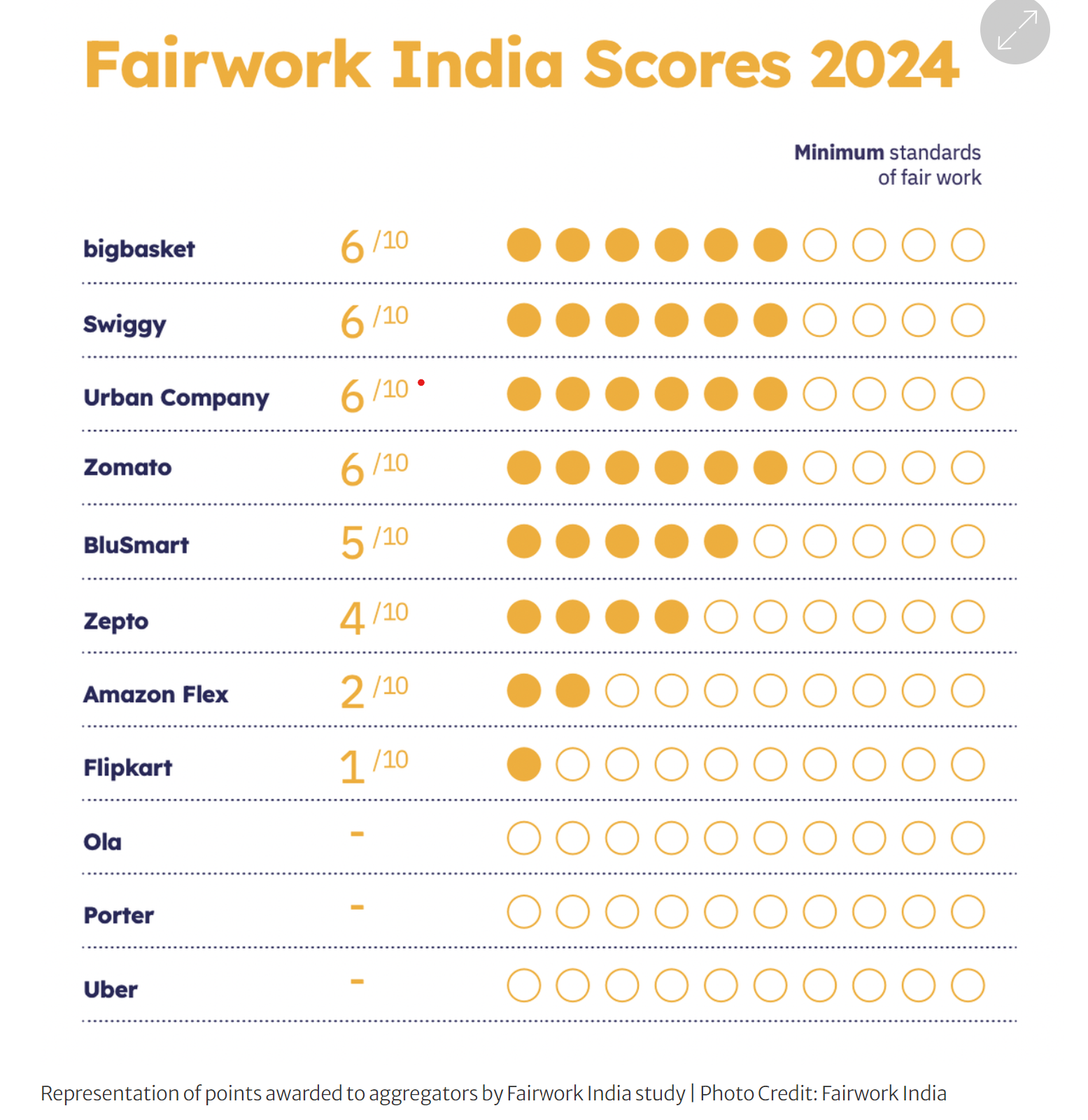
- 06 Oct 2024
In News:
The Fairwork India Ratings 2024 report, which analyses the work conditions of platform workers on digital labour platforms in India, draws a picture of aggregators who are non-committal to ensuring that workers earn the local living wage and unwilling to recognise collectivisation of workers.
Key Findings:
- Overall Performance: No platform scored above six out of ten, and none achieved top points across the five assessed principles: Fair Pay, Fair Conditions, Fair Contracts, Fair Management, and Fair Representation.
- Study Background: This report is the sixth annual analysis conducted by the Fairwork India Team, in collaboration with the Centre for IT and Public Policy (CITAPP), IIIT-Bangalore, and Oxford University.
Analysis of Welfare Legislation
- The report discusses the evolving nature of platform work and its implications for proposed legislation affecting gig workers in Karnataka and Jharkhand.
- Political interest in gig workers' welfare has increased, but the effectiveness of these initiatives remains uncertain.
- Professors Balaji Parthasarathy and Janaki Srinivasan highlight the importance of ongoing research and advocacy for improving gig worker conditions.
Methodology
- Principles of Assessment: Platforms were evaluated based on five principles, each consisting of two points—one that could only be awarded if the first point was fulfilled.
- Data Collection: Worker interviews were conducted across multiple cities, including Bengaluru, Chennai, Delhi, Kochi, and Thiruvananthapuram.
- Platforms Analyzed: The study included 11 platforms from various sectors, such as logistics, food delivery, and personal care.
Detailed Findings by Principle
Fair Pay
- First Point: Bigbasket and Urban Company were recognized for implementing a minimum wage policy ensuring workers earn at least the local minimum wage.
- Second Point: No platform met the criteria for committing to a local living wage after work-related costs.
Fair Conditions
- First Point: Platforms such as Amazon Flex, BigBasket, and Swiggy provided adequate safety equipment and training.
- Second Point: BigBasket, Swiggy, Urban Company, Zepto, and Zomato offered additional protections, including accident insurance and compensation for medical-related work absences.
Fair Contracts
- First Point: BigBasket, BluSmart, and others ensured contract accessibility and data protection protocols.
Fair Management
- First Point: Amazon Flex, BigBasket, and several others provided due process in disciplinary decisions.
- Second Point: BluSmart, Swiggy, Urban Company, and Zomato were noted for regular external audits and anti-discrimination policies.
Fair Representation
- Despite increased collectivization efforts among platform workers, no platform showed a willingness to recognize collective bodies, underscoring a critical gap in worker representation.
Conclusion
The Fairwork India Ratings 2024 report highlights significant challenges in ensuring fair work conditions for platform workers in India, stressing the need for continuous advocacy and reform in the gig economy.
National Urban Livelihood Mission (NULM)
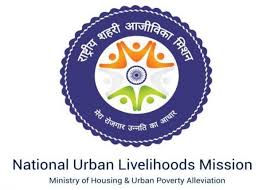
- 05 Oct 2024
In News:
The Government is set to launch NULM 2.0, the latest iteration of the National Urban Livelihood Mission (NULM), aimed at enhancing the livelihoods of urban poor and vulnerable populations. This version will specifically target six key groups: construction workers, gig workers, waste management workers, care workers, domestic workers, and transportation workers.
Overview of DAY-NULM
The Deendayal Antyodaya Yojana-National Urban Livelihoods Mission (DAY-NULM) was initiated in 2014 by the Ministry of Housing and Urban Affairs to replace the Swarna Jayanti Shahari Rozgar Yojana. It aims to uplift urban poor through organized self-help groups (SHGs), skill development, and access to credit.
Key Features:
- Funding Structure: DAY-NULM operates as a Centrally Sponsored Scheme, with a funding ratio of 75:25 between the central and state governments, adjusted to 90:10 for North Eastern and Special Category states.
- Mobilization of Women: The mission has successfully formed over 831,000 SHGs, mobilizing more than 8.4 million urban poor women by 2023.
- Objectives: It focuses on sustainable livelihoods through skill development, financial access, and entrepreneurship, particularly for women.
Components and Achievements
DAY-NULM includes various initiatives such as:
- Skill training programs.
- Support for self-employment.
- Rehabilitation for street vendors.
Performance Highlights:
- Over 89.33 lakh women have joined SHGs, with 6.12 lakh receiving initial funds.
- Approximately 15 lakh individuals have undergone skill training, leading to employment for 8.20 lakh.
- Surveys have identified 53.76 lakh street vendors, resulting in significant documentation and support.
Introduction of NULM 2.0
NULM 2.0 is a revamped initiative designed to further support urban livelihoods through financial aid and infrastructure enhancements.
Key Features:
- Microcredit Access: Eligible individuals can obtain microcredit of up to ?4 lakh, while groups can access up to ?20 lakh, with a subsidized interest rate of 5%.
- Support for Enterprises: The funding aims to assist beneficiaries in starting small businesses, creating social infrastructure, and providing grants for innovative projects, such as sanitation machinery.
Pilot Initiative
To effectively implement NULM 2.0, the government will conduct a pilot program in 25 cities. This will focus on:
- Identifying urban poor populations.
- Ensuring targeted assistance to improve beneficiaries’ earnings and living conditions.
Conclusion
The rollout of NULM 2.0 represents a significant step in addressing the needs of the urban poor, with a comprehensive framework designed to provide financial support and improve livelihoods. By focusing on critical worker groups and leveraging microcredit, the initiative aims to foster sustainable development and enhance the quality of life for urban vulnerable communities.
Women Entrepreneurship Platform
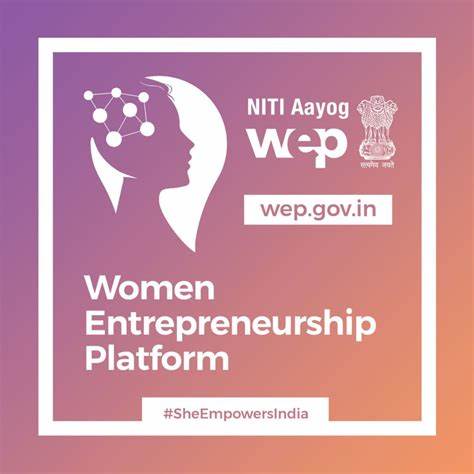
- 01 Oct 2024
In News:
Telangana has become the first state in India to establish a chapter of NITI Aayog’s Women Entrepreneurship Platform (WEP), aimed at promoting and supporting women entrepreneurs across various sectors.
Overview of WEP
- Objective: To provide women entrepreneurs access to resources, tools, and networks for business growth.
- Previous Operation: WEP was primarily a Central Government initiative before this chapter's establishment.
Launch Details
- Event: The WEP Telangana Chapter was launched in Hyderabad.
- Key Figures:
- NITI Aayog CEO BVR Subrahmanyam
- State IT and Industries Secretary Jayesh Ranjan
- Co-chair of WEP Sangeetha Reddy
Customised Support for Women Entrepreneurs
- Services Offered:
- Digital skilling
- Access to financial services
- Mentorship
- Market linkages
- Implementation Body: WE Hub will serve as the nodal body for the scheme in the state, leveraging its expertise to empower women entrepreneurs.
Importance of Women Entrepreneurship
- Economic Impact: Emphasis the crucial role of women entrepreneurship in India's economic future.
- Challenges Addressed: The initiative aims to overcome barriers faced by women entrepreneurs in finances, mentoring, and marketing.
Future Expansion Plans
- Vision for Growth:
- Principal Economic Advisor Anna Roy outlined plans to expand WEP to tier 2 and 3 cities.
- The initiative aims to build an inclusive entrepreneurial ecosystem through a hub-and-spoke model.
WE Bridge Initiative
- Leadership: WE Hub CEO Sita Pallacholla appointed as mission director for the WEP Telangana Chapter.
- State’s Advantages: Telangana was chosen for its supportive environment for entrepreneurship in Self-Help Groups (SHGs) and its robust innovation ecosystem.
- WE Bridge: Introduced as a single-window platform for women entrepreneurs in the state.
Benefits of the Partnership
- Access to Resources: The collaboration with NITI Aayog will enhance opportunities for women, providing access to funding, technology, and networks.
- Mentoring Emphasis: Sangeetha Reddy highlighted the critical role of mentoring in business success.
Objectives of WEP Telangana
- Skill Empowerment: Enhance digital technology and financial literacy among women entrepreneurs.
- Mentorship Connections: Link women entrepreneurs with industry leaders for guidance in business development, marketing, and scaling.
- Market Access: Facilitate connections with potential investors and industry partners through WE Hub’s extensive network.
